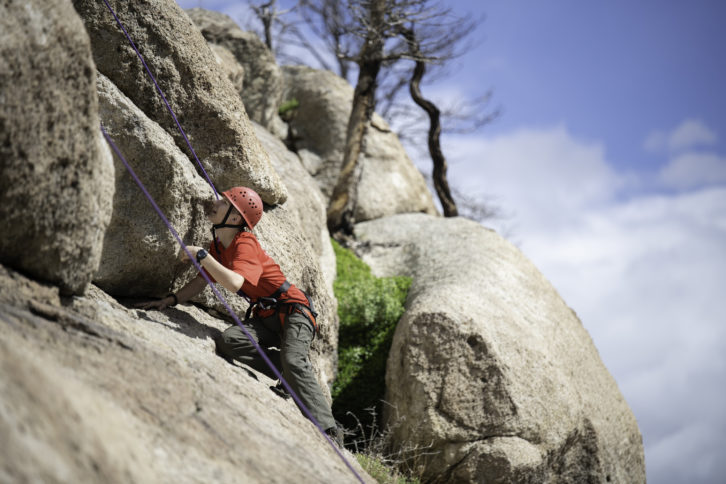
I’ve wanted to attend Philmont Scout Ranch in Cimarron, N.M., ever since I was a young Scout. One of my older buddies in the Troop, a cool kid named Billy Murdoch, came back sporting the distinctive “Arrowhead Award” hanging from his pocket. You can’t buy this patch. You have to earn it through a series of trials, including a 50-plus-mile trek through the New Mexico backcountry, completion of a three-hour conservation project, observing “Leave No Trace” camping principles, and returning with all crew members within the 12-day trek timeline. I decided to go into the experience with an open mind, hoping some great learning would occur. It did, and while there were too many lessons to list here, what follows are 10 key points that stuck out.
Related: Leveraging The EDGE Method
- Let Go to Grow — Lord Robert Baden Powell, founder of the Scouting movement, offered this admonition to his embryonic program in the early 1900s: “Scouting is a game for boys under the leadership of boys under the direction of a man.” This can be difficult for adults in today’s “helicopter parent” world. A good Philmont crew, like a good Scout patrol, runs best with adults enabling the group the way a grandfather may coach a boy from afar every now and again during a fishing trip. When it’s done properly, the boys bloom in their surroundings through failure, letting experience teach them what years of Mom’s and Dad’s words couldn’t. What looked like a wild group of hyenas at the beginning of our trek turned into a well-oiled machine at the end because of the adults’ willingness to let go. How many CI businesses are held back by key figures unwilling or unable to let go? According to Liz Wiseman’s book Multipliers, there are two kinds of managers — multipliers and diminishers. Multipliers get more out of their teams than their members could produce individually while diminishers choke out growth by making themselves the center of the universe. Which one are you?
- “Is Anyone Not Ready?” — The crew asked this question anytime we were about to hit the trail or at the end of the break. Instead of asking the question the other way around, it triggers an immediate response from anyone still needing more time. It’s then that person’s responsibility to ask the question again before everyone gets underway. There are so many questions in our daily lives to which we’ve become noseblind. Consider the sales opener, “Is now a good time?” Change it to, “Is this a bad time?” and watch your positive response rate skyrocket. By introducing cognitive dissonance into a dialog, you now have a leg up over those stuck on autopilot.
- The Slowest Man Sets the Pace — One of our boys hurt himself a few days into the trek. His knee injury could’ve been a trip-ender, but thanks to us catching on immediately and his youthful ability to recover quickly, things ended up okay. One of the quick changes our crew leader made was to put him up front, which slowed the group down tremendously but assured that we weren’t going to leave him behind. We could monitor him as we progressed along the trail, and this approach enabled everyone to finish the trek. Our businesses are no different. Whether or not we’ve put them out front or not, our slowest folks are setting the pace. Unlike a crew, where the goal is a 100 percent finish, no matter the speed, a business needs to evaluate the slow people a little differently. Why are they slow? Do they need accommodations, coaching, or maybe they’re a bad fit? No matter the reason, your business needs to constantly strive to produce a crew that’s fast and smooth. Keep swapping out members of the crew until you hit the mark.
- One Foot in Front of the Other — There were some days at Philmont where the crew began to break down a bit. We began our longest day by hiking 2.6 miles in the wrong direction before even beginning a 10-plus-mile hike over steep, technical terrain all placed squarely in the 100-plus-degree midday heat. By the early afternoon we’d all stopped cracking jokes and just began plodding along, one foot in front of the other. The only other time I’ve needed to go into that headspace has been while running marathons or competing in Ironman events. Slowly and steadily, we reached our campsite after what felt like an eternity. We all sat there, dazed and confused, for a good two hours before starting to move around again. Our businesses have these cycles, specifically in times of economic hardship. It can seem like we’re stuck in mud and nothing’s going our way, but the winner of the day always keeps their head down and takes it one day at a time.
- Plan Your Hike & Hike Your Plan — I stole this one from scuba diving, fair and square. No one wants to be guessing about where the crew is headed with a 55-pound pack strapped to his back. Proper, prior preparation is key to minimizing wasted effort and getting lost. Each morning our crew navigator would brief the boys on the anticipated route and ask if they had any questions. He’d then ask them to declare their approval before setting off. This assured everyone was on the same page and dissenting opinions were taken into account, even if it ended in a “disagree-and-commit” situation. When run properly, our companies should all orient around a similar planning cycle. One-year strategic plans are common in small businesses where employees attempt to solve two to three thorny challenges over 12 months. By posting your plan publicly and talking about it rhythmically throughout the year, everyone’s on the same sheet of music and marching together.
- Don’t Let Your Guard Down — We found the Philmont day consisted of three distinct cycles: freezing, burning, and drowning. Each morning dawned with shivering and frosty breath followed quickly by the midday sun beating down on us like a Mike Tyson left hook. Each afternoon served up a dessert course of torrential rains lasting one to two hours. These rapid changes in weather meant we all needed to carry gear for each cycle with us at all times. Those who didn’t heed the gear guidance were sent scrambling each time the weather changed. And change it did. How often in our businesses do we understand the cycles of boom and bust but don’t prepare enough for downturns in times of plenty? Do we ever take success for granted and turn a blind eye to markets shifting around us?
- Be Prepared for Anything — We were told Philmont was filled with bears, rattlesnakes, mountain lions, and other predators, necessitating the need to put any smellable items in a “bear bag” each night, which one of our crew members would hoist like a hangman between two trees. We didn’t see any of these predators for the first few days and began to wonder if the staff were laying it on a little thick. That all stopped as we were walking back from an evening program only to see a 4-foot rattlesnake slithering across our path. Chills ran down my spine as the snake began to coil. Needless to say, on the way back to camp, everything looked like a snake. Our job sites can offer some of these same lessons especially when it comes to using power tools and retrofit environments. If we take our eye off the ball, even for a moment, injuries can happen in the blink of an eye. Consider evaluating your safety program and publicly posting a “Days Without Incident” number for all employees to see.
- Don’t Stand Still or You’ll Lock Up — Our crew leader called for breaks every 30 minutes. These respites allowed us to catch our breath, hydrate, and take on calories. Our stops started getting stretched out as the days wore on and the boys would call for a 20-minute versus a 5-minute break. I quietly mentioned to the crew leader that, just like the Tin Man in The Wizard Of Oz, we were likely to seize up after stopping for too long. He agreed and began limiting our breaks to shorter stops. Taking time to catch our collective breath after a big push, project, victory, or completed initiative is a great idea, but resting too long can catch us flat-footed, losing momentum.
- Savor the Moments of Beauty Along the Way — So much of the Philmont trek can feel like painful uphill climbs contrasted with equally tortuous downhill slogs. All of these trials take place in some of the most stunning country I’ve ever seen. Whenever the going got tough, all we needed to do was look up and out for a reminder of why we were all out there. Running a business is hard work, and it’s tough to savor moments of victory (especially if you’re a workaholic). If we can’t savor these moments, when will we savor anything?
- Find the “Goldilocks Zone” With Gear — Too much or too little? We feared landing on one end or the other of this gear continuum before departing for Philmont. We had access to dozens of checklists and the sage wisdom of plenty who’d gone before us. I decided to take our Scoutmaster, Ian Coddington, at his word, and only included what was on his packing list. “If it’s not on there, you don’t need it,” he said. I nervously packed my bag with items like a flannel shirt and a bandana, both of which I couldn’t fathom needing. They seemed like items my dad would’ve taken. My perspective changed rapidly as the days wore on. By Day 3 I was a bandana-wearing, flannel-shirt-sporting Coddington convert. The boys and other adults shared similar sentiments as we mused about how best to achieve the ultimate “Goldilocks Zone.” Are there products and services in your business that aren’t making money? Do you have team members who aren’t contributing their fair share? You owe it to the rest of your people to constantly prune your company’s branches, allowing the entire organization to thrive.
There may be a few other things I didn’t learn at Philmont that guide me in business, but not many. How will you take these lessons and apply them to your own company?







